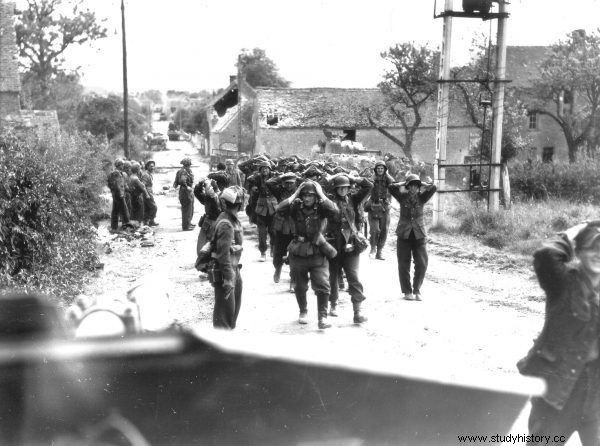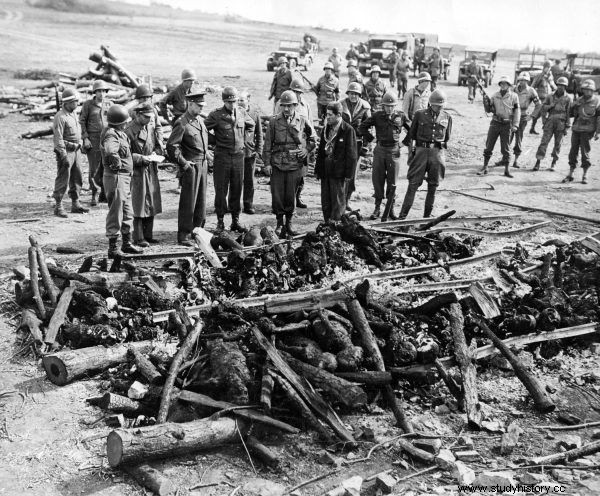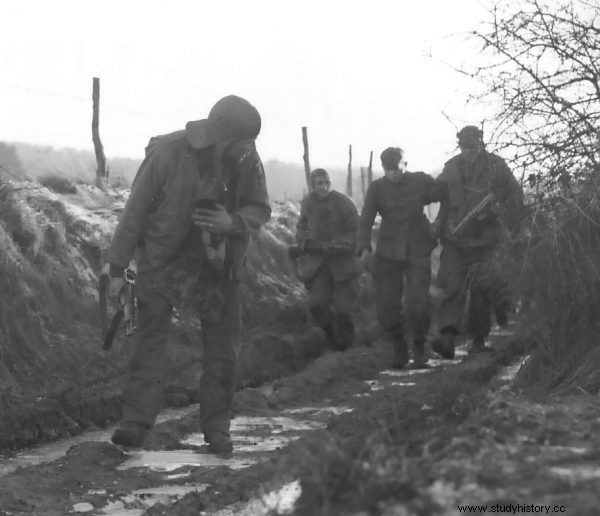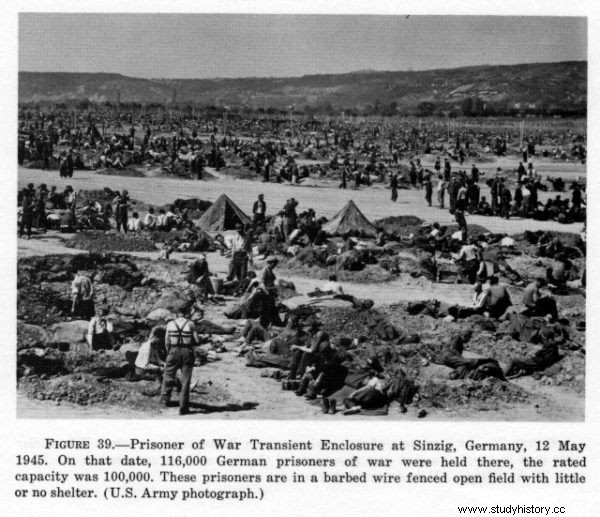During the victorious march from the beaches of Normandy to the Elbe, US soldiers committed a mass of crimes. Most of them were turned a blind eye, and some took place with the consent of the commanders. They have never been settled.
Before the invasion of occupied France, American soldiers underwent a series of training sessions, during which they inculcated hatred towards the German nation. In order to deepen the aversion to the enemy, many gruesome acts committed during the war were invoked by the Nazis.
Like trampling an insect
The first American crimes took place during the initial fighting in Normandy. Paradoxically, the propaganda of the Third Reich also contributed to this. Long before the expected invasion, she announced that the first units to appear in France would be airborne units. American paratroopers have been portrayed as released from prisons.
When on the night of June 5-6, 1944, the Allied air force launched an airborne landing, the German defense did not hesitate to fire at the helpless jumpers descending to the ground. Many Yankees fell into Nazi hands after they landed. They were often murdered in a brutal way.

American paratroopers of the 101st Airborne Division in the first days of the Normandy invasion. In the foreground, James Flanagan with a captured Nazi flag in his hands (photo:U.S. Army, public domain).
These events confirmed the thesis about the ruthlessness of the Nazis and automatically resulted in greater aggression of the Americans. There were the first cases of killing German prisoners of war. It even happened that the wounded were killed. When paratroopers - extremely alienated from the enemy - found an American watch or even cigarettes in their captured enemy, he usually ended up immediately with a bullet in his head.
There was a group among American soldiers that wanted to get even with the Nazis. Some of them had fought before against the armies of the Third Reich in Africa or Italy and had something to prove. Others wanted to get back for the death of a loved one.
Pluto. Guarnere of the 101st Airborne Division burned for revenge for his brother's death, and he unscrupulously shot several prisoners. After many years, he recalled the event as follows: I did not have any remorse. It was as simple as trampling an insect.

German soldiers captured by Canadians at Saint-Lambert-sur-Dive, August 21, 1944 (Photo:Donald I. Grant / Canada. Dept. of National Defense / Library and Archives Canada / PA-116586).
Deserter, or gangster
After the Allied victory at Falaise, the defeated German troops were relatively easy to push beyond the borders of France. For some time, the Americans and the British ceased intense combat operations. This was due in part to the lengthening of communication lines, as the supply bases were still in Normandy.
This situation led to a decline in the ranks of the Americans. A small percentage of all the forces on the continent were at the front line. The others, using their passes, were looking for other activities than the warrior.
Many soldiers thought that they had already fulfilled their duty and that they deserved appropriate compensation for a job well done. There were many cases of rape, looting and trafficking in stolen goods. There were even opinions among civilians that the behavior of German soldiers during the occupation was much more correct .
Organized groups of deserters became particularly dangerous, the character of which the French press called "Chicago". An example would be Cpl. Alfred T. Whitehead. This former participant in the fighting in Normandy became famous for robbing Allied supply depots and ordinary residents in Paris.
Many were like him. A group of people became infamous when they began collaborating with the Corsican mafia and earned money from illegal trade. The French police were unable to deal with the gangs of American deserters and repeatedly called on their compatriots from the gendarmes for help.
Ardennes - the next crime wave
The unexpected German counteroffensive in the Ardennes was connected with new Nazi crimes, which was not left without an American response.
The climax that infuriated the Yankees was the Malmedy massacre. Joachim Peiper's SS men murdered 84 American prisoners there. After these events almost all captured members of the SS formation were killed on the spot . Admittedly, the soldiers of these units were treated particularly harshly before, but only now has their apogee been reached.

American generals did not intend to prosecute their subordinates for the murders committed on German prisoners of war. What they saw in the German concentration camps probably confirmed their decision (here Generals Eisenhower, Bradley, Patton and Eddy at the Ohrdruf camp on April 12, 1945) (photo:public domain).
Wehrmacht soldiers were often treated little better. The Yankee paratroopers made a specific selection and shot and killed many captured Germans wearing U.S. infantry footwear.
In turn, those caught in the shoes of American paratroopers were led barefoot among snowdrifts in a dozen or so degrees of frost. After some time the prisoners' frostbitten feet refused to obey and required immediate amputation .
The spiral of violence was additionally spun by a group of Skorzeny's commandos. This unit, disguised as American uniforms, got to the rear of the enemy troops and carried out a subversive action there, driving the Allied commanders crazy.
Antony Beevor mentions in his book "Ardennes 1944 that the Yankees feared these swindlers so much that they often killed surrendering Nazis who wore pieces of American uniform found on the battlefield due to low temperatures.

American soldiers lead a captured SS man. He was lucky not to be shot on the spot (photo:public domain).
Killing prisoners? We don't know anything…
The commanders were well aware of the crimes committed by their subordinates. Antony Beevor notes in his work on the Ardennes that General Bradley himself was favorable to the shooting of captured Germans. Of course, it was rarely officially commented on, and various events spoiled the reputation of honorary U.S. soldiers. The Army tried to sweep under the carpet.

The article was based, inter alia, on on Anthony Beevor's book "Ardennes 1944. Hitler's Last Chance" (Horizon Mark 2016).
Beevor also quotes General Patton: There were some unfortunate incidents as a result of which the prisoners were killed. I hope we can cover it up . This statement refers to the massacre in the village of Chenogne, where about 60 captured German soldiers were murdered.
On December 21, 1944, the staff of the 328 Infantry Regiment issued a document, the content of which reads as follows: Not to take prisoners, but to shoot SS men and paratroopers on the spot.
In the Reich, everyone is an enemy
When the Allies entered Germany in the spring of 1945, "new perspectives" appeared for the American troops. They were now in the country of the hated enemy, so there was a common feeling that plunder and plunder could be made to the point .
The awareness of the earlier atrocities inflicted by the Nazis only confirmed the Yankees in this belief. All the more so because a significant part of the Third Reich society was unfavorable to the invaders from the West, and the Hitler Youth or Volkssturm troops, saturated with Nazi ideology, caused
Attention! You are not on the first page of the article. If you want to read from the beginning click here.German women also fell into the spoils of war category. During this period, the US Attorney's Attorney every week about 500 rape cases! The robberies, in turn, were repeatedly carried out for entertainment. It happened, for example, that the Americans stole an ambulance and took a ride. It was only after some time that they noticed that a German doctor was giving birth in the rear part of the vehicle.
The executioners are victims
More and more Germans were captured by the Americans every day. The Allied command was not prepared for such a large number of surrendering enemy soldiers. Many of the camps where the Nazis were held were not much different from those on the Eastern Front.

The American camp for German prisoners of war in Sinizig, May 12, 1945 (photo:public domain).
Diseases were common, leading to the deaths of many prisoners. There are many indications that Americans are sluggish in providing their detainees with shelter, hygiene, and food.
In the final phase of the war, the Americans liberated many concentration camps. The images they saw there surpassed all their ideas about the bestiality of the Third Reich. In many places of this type, German crews were massacred.
A particularly gruesome course took place in the lynches in Dachau. Yankees and prisoners murdered about 500 Germans there . Lt. Jack Bushyhead, in particular, has become notorious there. When he saw the hell that the Nazis had prepared for the prisoners, he said: We cannot live in the same world as them. They are beasts. They must be destroyed. Moments later, on his orders, more than half of the victims of the entire massacre were to die.
Fanatic Germans
Usually, the crimes committed by the units under the "Star Banner" were the result of a desire to take revenge for the atrocities committed by the Germans . There was also a deeply rooted conviction among the Yankees that each of them, as the liberator of Europe, had the right to decide about the fate of a defeated nation.

American soldier over the bodies of Germans killed during the lynch court in Dachau (photo:National Archives and Records Administration, College Park Central Zionist Archives, public domain)
Shoe and unrepentance often found among Germans in the last weeks of the war, they only strengthened this belief. It was them that caused the Americans to shoot one of the SS men during a meal during the aforementioned liberation of Dachau:
- Who are you? - asked the soldier […]
- SS.
- How could you do such things? Someone whispered.
The SS man shrugged.
- Those human pigs…
He was lifting a spoonful of beans to his mouth when they shot him.
Certainly, the scale of the crimes committed by the Americans was much smaller than those committed by German or Soviet soldiers. After all, they should not be hidden behind a veil of silence. For many years this has been done, because history is written by winners.
